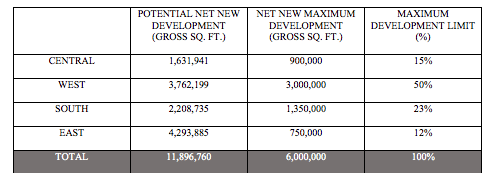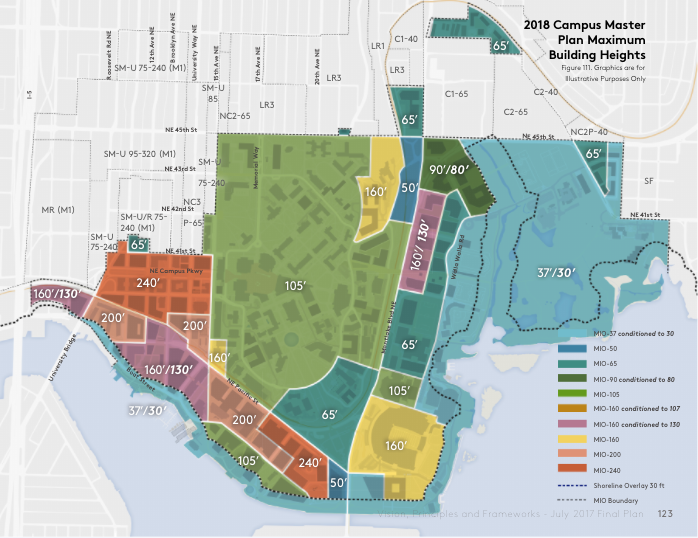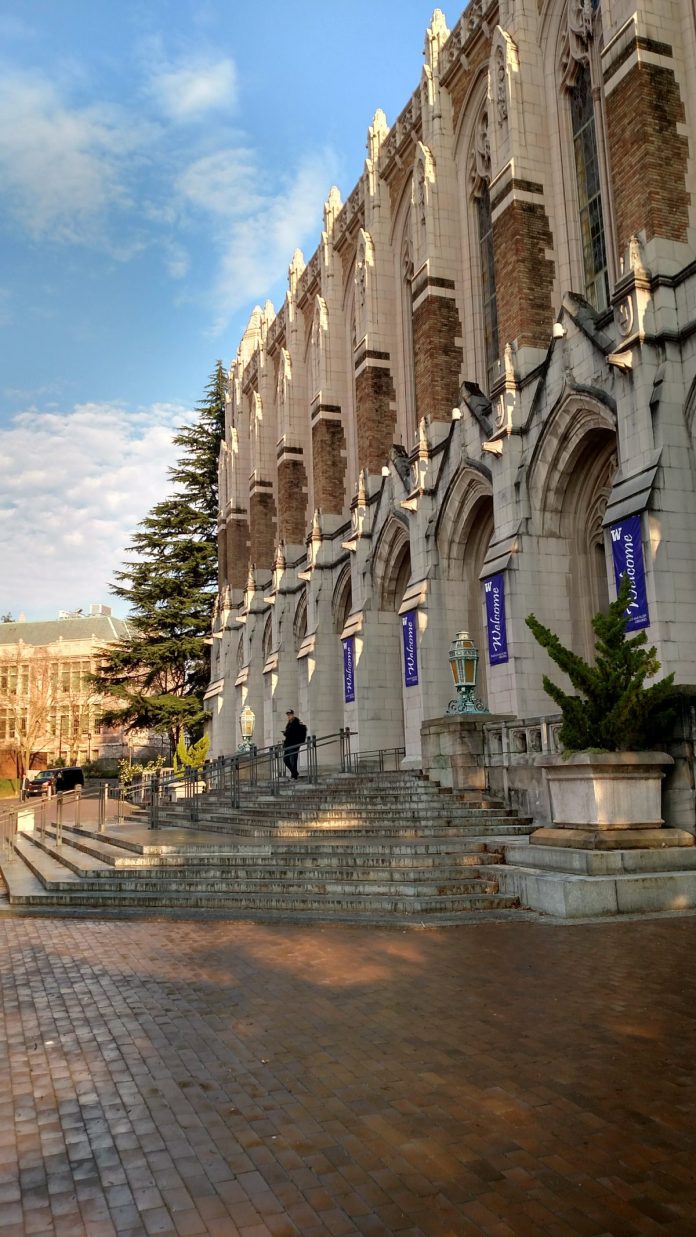Flying under the radar, the University of Washington’s campus master plan update received a recommendation by Seattle Hearing Examiner Sue Tanner in mid-January. In the 37-page recommendation, the Hearing Examiner provided extensive discussion on the campus master plan proposal and conditions for approval. A total of 59 conditions are recommended, which mostly deal with transportation, urban design, and historic preservation issues. A coalition of community leaders, however, are not satisfied with the conditions and plan to file an appeal today. Pending appeal, the proposal will move into the hands of the Seattle City Council for consideration.
Background
Under the University of Washington’s plans, the main campus would expand by an additional six million square feet of housing, educational, commercial, community, and supportive space above the current development cap. The university estimates that space needs at the main campus will grow through 2028 with students and faculty increasing by 20%. Most of the added development capacity would end up in the West and East campus sectors as opposed to the central campus.

In November, the Seattle Department of Construction and Inspections (SDCI) released their list of recommended conditions for the proposal. Then in December, a three-day public hearing on the matter was held by the Hearing Examiner. The University of Washington disputed some of the recommended conditions, including on topics related to transportation mitigation, affordable housing requirements, and public realm standards. Following the public hearing, SDCI and the University of Washington attempted to resolve areas of disagreement on conditioning, which led to some small tweaks to language and the dispensation of one condition related to the requirement for bike parking which was entirely withdrawn by SDCI. However, SDCI mostly held their ground on imposing conditions related to transportation.
Hearing Examiner’s Key Conditions
The Hearing Examiner generally agreed with the interpretation of SDCI and found its conditions to have a reasonable nexus to the impacts proposed under the campus master plan. Specifically, the Hearing Examiner upheld some key conditions:
- A condition requiring the University of Washington construct at least 150 affordable housing units set aside for faculty and staff of the university earning less than 60% of the area median income. The affordable housing would need to be constructed on or within close proximity to the campus prior to fully realizing the additional development capacity under the campus master plan or the life of the plan, whichever were to come first. The University of Washington was opposed to this in part because the city relied upon housing policies (H5.19) in the city’s comprehensive plan. However, the Hearing Examiner affirmed the conditions.
- A target of 15% drive-alone rates to the university campus would need to be achieved within one year of Lynnwood Link opening. A higher 17% rate would be allowed within one year of Northgate Link opening. The baseline target is a 20% rate. Failure of the university to meet the reduced drive-alone rate targets would mean that various transportation management program techniques would need to be used, including a minimum transit pass subsidy of 50% for staff and faculty, UPass integration with bikeshare and carshare, and modifying paid parking strategies.
- To facilitate increased transit demand at the campus, the university would need to pay King County Metro Transit to operate additional peak morning and afternoon trips. The university would also need to pay for several RapidRide corridor capital improvements near the campus, dedicate space for transit riders in new developments adjacent to existing and new light rail and RapidRide stops, and expand stops along three stretches (NE 45th St, 15th Ave NE, and NE Pacific St) of future RapidRide corridors near the campus.
- Any public streets under the city’s control would need to be improved to city code and right-of-way manual standards when new development occurs adjacent to such streets.
The university was partially successful in getting some conditions slightly modified, such as:
- A requirement that the university pay a proportionate share for installation of new intersection signals at University Way NE and NE 41st St as well as 6th Ave NE and NE Northlake Way was modified downward in contributions.
- Contributions to pay for local intelligent transportation system improvements would still be required, but are less than SDCI had requested.
The Hearing Examiner also declined to recommend two reductions in height for the West Campus area requested by the City-University-Community Advisory Committee (CUCAC). Regarding Site W22, the Hearing Examiner wrote that “although some may consider it a gateway to the neighborhood, the site is not on the campus boundary and is proximate to the Seattle Mixed-University 75-240 zone that would allow structures up to 240 feet in height.” Separately, the Hearing Examiner dispensed with the CUCAC-requested height reduction at Site W37. “The University has identified a view corridor at this location, and because the topography rises to the north of the site, most of the square footage allocated to the site will be outside the view corridor,” she wrote. Ultimately, the recommended zoning is similar to what the university requested this summer and is as follows with limited exceptions for lower maximum heights at Sites W19, W20, W31, and W32:

Community Concerns
Community leaders and employees expressed concerns with the recommendation. Known as U District Alliance for Equity and Livability, the group comprises more than a dozen organizations that want to see a better campus master plan that puts staff, students, and the community first. Many students and employees have increasingly found it harder to commute to the university, obtain affordable housing, and deal with basics like childcare, which is why they want a more holistic plan.
Josh Castle of the Low Income Housing Institute said that the amount of affordable housing recommended by the Hearing Examiner falls well short of the need. A minimum of 560 units for households at or below 50% of the area median income and 160 units for households between 50% and 80% of the area median income to help struggling students, staff, and faculty. Unlike other rezones throughout the city, the campus master plan isn’t subject to ordinary Mandatory Housing Affordability requirements.
Emily Sharp, a physical therapist at the University of Washington Medical Center, highlighted the unaffordable costs of childcare that she bears. “The childcare cost for my three-year old was over $1,700/month at a U-District center,” she said. “I still pay more than $2,000/month including my older child’s after school care. We need more family-friendly support from our employer.” The campus master plan does address childcare and suggests that the ratio of childcare spaces to campus population would eventually fall within the band for other peer universities. However, cost and access is a clear problem for students, faculty, and staff.
Bill Roach, a Sierra Club leader, spoke about several concerns on transportation. He said he appreciated that the Hearing Examiner saw merit in reducing single occupancy vehicle trips to 12% of all university trips; however by settling for the staff recommendation of 15% it did not go far enough. Roach said that the university’s baseline plan would add nearly 6,200 additional single occupancy vehicle trips and cause five more intersections (totaling 11 out of 13) to reach a Level of Service of E or F and dramatically increase delays. Such an outcome wouldn’t just be more inconvenient for drivers, it would also directly hamper the ability for buses to connect residents, staff, and students with the places they need to go even with modest speed and reliability improvements.
One of the best things that the university has done, he said, was adopting the UPass back in 1990. At the time, it was a mere $24 per quarter (with inflation $48). Now, however, the UPass stands at well over $150 per quarter for staff and faculty and remains the biggest impediment to realizing lower single occupancy vehicle rates. Roach and many university employees have long-pushed for free UPasses for staff and faculty. In letter to the city, the Sierra Club poignantly noted that “the staff drive-alone rate was 38% in 2002 and was still 36% in 2016 and remains relatively flat even with the arrival of light rail” and “staff represents 46% of the projected SOV rate in 2028 and should be the major target for UPass usage.” The university, however, contends that free UPasses are not possible without action from the state legislature mandating and funding them.
On parking, Roach suggested that the university parking cap of 12,300 space is an outmoded agreement that needs to be revised downward. He said that for several reasons. First, the cap excludes 750 spaces in the University of Washington Tower. Second, the cap was set nearly three decades ago in 1990. And third, he believes that the University of Washington “needs to right size its parking supply.” Similarly, Roach said that the university should be required to provide covered and secure bicycle parking, which students have clearly said they want in past surveys. The Hearing Examiner’s recommendation, however, would remove any reference and standard for bicycle parking provisions.
Finally, Roach said that the university should be required to deliver Burke-Gilman Trail improvements sooner rather than later. The university promises to complete trail expansion and bicycle-pedestrian separation by 2028, but Roach said that these improvements should come earlier, perhaps as soon as 2021 to accommodate existing and future commuters. The trail is already failing to meet existing demands.
Pending appeal, the Seattle City Council’s Planning, Land Use, and Zoning Committee could take up discussion on the recommended campus master plan this year. Where they land on a final decision is not yet clear.
SDCI Releases Recommendation on UW’s Campus Master Plan, Community Leaders Remain Concerned
Stephen is a professional urban planner in Puget Sound with a passion for sustainable, livable, and diverse cities. He is especially interested in how policies, regulations, and programs can promote positive outcomes for communities. With stints in great cities like Bellingham and Cork, Stephen currently lives in Seattle. He primarily covers land use and transportation issues and has been with The Urbanist since 2014.



